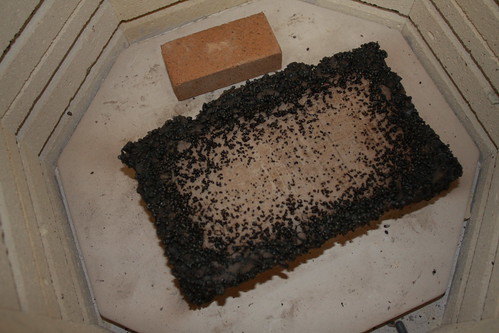 Yeah, it's a bust. So I ramped it to 300 F. It soaked for another 2 hours. Did the mirror test with the kiln lid cracked about 20 minutes from the end of the soak. (You hold a mirror next to the opening to see if you get any vapor condensing on the mirror.) Good to go.
Yeah, it's a bust. So I ramped it to 300 F. It soaked for another 2 hours. Did the mirror test with the kiln lid cracked about 20 minutes from the end of the soak. (You hold a mirror next to the opening to see if you get any vapor condensing on the mirror.) Good to go.I went about my business chasing down some screwed up wiring in the house. About 45 minutes later I start to smell the seeds burning. Okay, that's about right I'm thinking. Checked it out.
Temp is at 554 F. Smoke is oozing out the crack between the lid and the kiln body. I got my welding gloves, opened the door to what you see in that picture. Hmmm ...
At first I thought I didn't let it soak long enough. I thought the big seeds were popping like they did in the toaster oven test. So I shut it down to let it cool. I was going to just let it soak at 300 F longer, write off the edges, and see what I could save.
Once the smoke cleared I noticed the large number of what looked like popped seeds. The larger seeds in the mix are not that numerous. This had to be the millet. At this point I am sure the seeds near the surface like this are dry too. I mean c'mon, they HAVE to be dry. So what's happening?
A guy at iforgeiron.com who goes by Frosty, mentioned he thought millet had a relatively high oil content. Seeds in general have a good bit of oil as we know. So, what I think is happening is that as the oil is vaporizing and possibly burning, it's acting just like water vapor and causing the seed to expand. It would take a lot more testing to prove this out. I'm not going to do that. So, that's my story and I'm sticking to it.
Anyway, seeds as a burn out filler for a refractory brick are a no-go. Well ... now we know.
So for the next rounds of testing, I will drop the seeds and replace them with perlite. As I mentioned, perlite and "fireclay" are a reported to work just fine. The mixes I've seen don't go as hot as I'd like. I think that's got more to do with the clay than the perlite.
Perlite contains lots of fluxes that'll lower the melting point of your kaolin substantially. Try the styrofoam.
ReplyDeleteSounds good to me. I'm going to order some now.
ReplyDeleteThanks!
-jd
Found a smaller package at:
ReplyDeletehttp://www.foamerica.com/default.asp